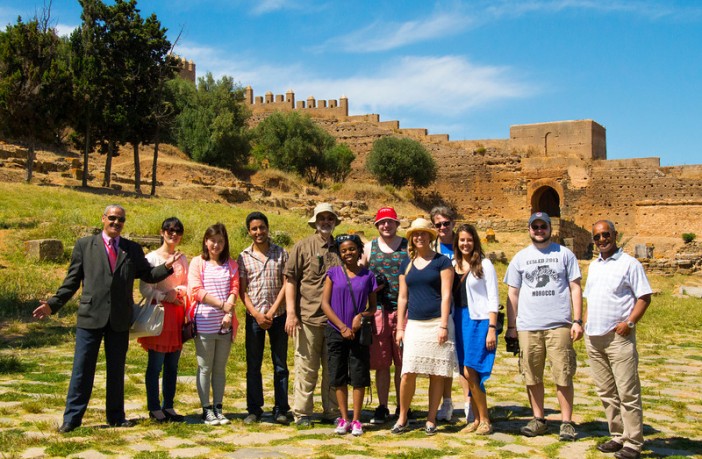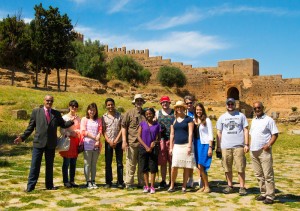An announcement that Indiana State University student McKenzie Meares heard in her class last fall piqued her interest – and led to the first time she ever traveled outside of the United States.
Meares was part of a group of six Indiana State students that toured Morocco to learn more about economic sustainability. The project was part of the Environmentally and Culturally Sustainable Local Economic Development, or ECSLED, initiative. The group traveled to sites and cities throughout the northwestern African nation to learn more about communities’ efforts to develop sustainable practices in areas where limited resources are commonplace.
“We got to see (sustainability) in different lights in the different environments the country had,” said Meares, a senior speech language pathology major from Indianapolis who first heard of the trip when it was announced in a course she was taking about sustainability. “There were a lot of different aspects of the economy that we were able to observe through our different experiences.”
Morocco has multiple different geographic landscapes, which provided the group with an opportunity to learn about the variety of challenges that people can face in such contrasting areas, said Tom Steiger, professor of sociology and director of the ISU Center for Student Research and Creativity.
“There are so many of them in such a small area,” Steiger said, “that literally you could go on a 10-minute bus ride … and you can go from a verdant green productive area like something you would see in Indiana to a lunar landscape.”
The group toured several cities, including Casablanca, and areas that included mosques, medinas and outdoor markets. They were able to witness locals haggle over freshly skinned animal carcasses hanging in booths, which included animals different from what the American visitors customarily consume.
“They see it, it’s on the bone. It is right there, and that was something that was a complete shock to us,” Emily Richards, a senior business management and economics double major from Terre Haute, said of the outdoor meat markets. “But there are little kids running around and people bargaining over the best cut of lamb they can get, or cow” or other animals.
The group was able to talk with local residents at the sites they visited. They also talked with some local officials, though more of the visits provided the chance to learn directly from area residents. In one such instance, they learned about how government officials changed their approach to resolving challenges associated with a limited water supply in one area by including the residents in the discussion, rather than imposing a policy, Steiger said.
“The policies that the government has had around water had been pretty much top-down and they haven’t worked,” Steiger said. “Now they’re getting much better cooperation from local farmers and people by including them, and this is the same with NGOs (nongovernmental organizations) or anybody else who comes in.”
The group visited a program associated with Hassan II University, in which students volunteer to run a trade school that teaches local residents agricultural jobs, such as raising chickens and effective composting techniques. People live at the school to participate in three-weeklong programs.
“It was cool because the students (from Hassan II) spend so much time there,” Richards said. “They volunteer quite a bit of their time there … because they wanted to, and because they felt they were making a difference in people’s lives.”
The students also visited localities that ranged from vacation homes to those with walls of mud and clay that featured a single light bulb. The students on the trip witnessed a range of backgrounds, including extreme poverty not typically seen in the United States, said Nancy Kaj, a junior economics major from the Democratic Republic of the Congo.
“Those places that we visited that were very poor were more sustainable than any places that we visited before. They know how to use the water, not waste it,” Kaj said. “How they build the houses, they know what to use so that they will have air and not too much of the sun because it’s very hot there.”
Kaj also provided a unique perspective on the journey. She speaks fluent French, which is one of the languages widely spoken in Morocco. On multiple occasions, she found herself acting as an unofficial translator between the group and locals, as English is not as widely spoken in Morocco.
“It’s not just knowing the language, and then you can be a translator,” said Kaj, who hopes to take classes to strengthen her skills. “You also need some other skills, which is also the notion of keeping the essentials and then give them to people, because you have to be very consistent.”
Through discussions with local residents, she learned more about different sustainable practices. She was informed that the government is establishing an initiative to expand the use of solar panels to create electricity for people in the country.
The Indiana State students also had the opportunity to witness some practices that are centuries old. At one stop, the group was greeted by locals with handfuls of freshly plucked mint to hold up to their noses as a makeshift shield before visiting a tannery, where locals were tanning leather hides in a chemical process used for generations, said John Conant, chairperson of the economics department at Indiana State.
“There certainly is that clash between preserving the old way of doing it and the environmental aspects of that,” Conant said. “You don’t want to preserve so much that you’re producing significant scales the old way, but having some to maintain their culture and to show students what it was like hundreds of years ago is a good thing culturally. You just don’t want to have to do it on a scale that’s going to harm the environment.”
The ECSLED trip was different from other study abroad trips, since the participants traveled to so many different areas and learned firsthand from local residents, several of the students said.
“I went to a school in Greece … and I lived in an apartment downtown, so this was a lot more travel,” Richards said. “You travel like every two days. You’re in a new city.”
Photo:http://isuphoto.smugmug.
Photo:http://isuphoto.smugmug.
Photo:http://isuphoto.smugmug.
Photo:http://isuphoto.smugmug.
Photo:http://isuphoto.smugmug.
Photo:http://isuphoto.smugmug.
Contact: John Conant, chairperson of the economics department, College of Arts and Sciences, Indiana State University, 812-237-2160 orjoh








